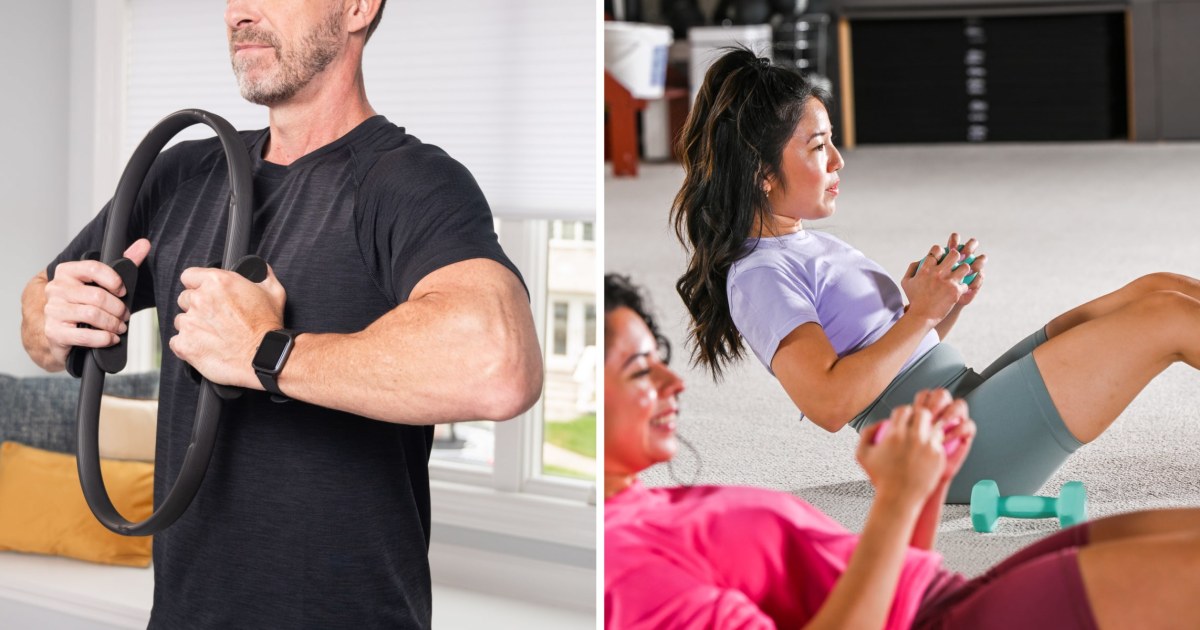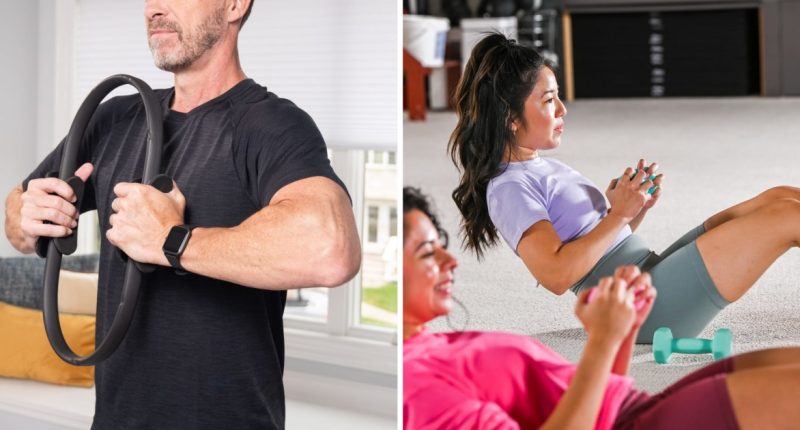
As far as full-body workouts go, Pilates is one of the most effective low-impact options you can do. It’s a challenging activity that involves strength training and stretching, and it’s beginner-friendly with plenty of opportunity to advance, says Vanessa Johnson, a master instructor for Club Pilates, a reformer studio with locations nationwide. Classes involve a series of controlled exercises that focus on building and lengthening muscles while connecting movements to breathwork to deepen each position.
There are two types of Pilates: mat Pilates, which leverages your own body weight and can be done without equipment, and reformer Pilates, which you do on a reformer, a machine with a spring-tension platform that rolls up and down along its frame. Both types offer benefits like improving strength, flexibility, mobility and alignment, and you can do them at-home or in a studio. That makes Pilates easy to fit into your lifestyle regardless of how much time you have to devote or where you live.
If you want to incorporate Pilates into your workout regime, we talked to experts about how to start and what to know beforehand. With their guidance in mind, we also put together a list of Pilates apparel and equipment to use during classes. All the products we recommend below are top rated, Select Wellness Award winners or staff-favorite items.
SKIP AHEAD Pilates apparel | Pilates footwear | Pilates equipment | Pilates apps
Our top picks
What is Pilates?
Pilates is a low-impact workout that focuses on strengthening and toning the body through a series of slow, controlled exercises, says Fuller. It was developed in the 1920s by Joseph Pilates. He was in an internment camp with other German nationals during World War I and while there, he developed the workout as a way to help rehabilitate soldiers who were unable to walk, says Meade. Because Pilates was born out of the idea that you can heal the body through movement, you can tailor exercises to be safe for all bodies, she says.
What are the benefits of Pilates?
The biggest benefit of Pilates is that it simultaneously stretches and strengthens the body, helping you work toward creating long, lean muscles, says Meade. “The Joseph Pilates guarantee is that ‘in 10 classes you’ll feel the difference, in 20 you’ll see the difference and in 30 you’ll have a new body,’ and it really is the truth,” she says. “Over time, you can feel your body changing and getting stronger with each session.”
Pilates, which also helps improve flexibility, is a type of functional fitness, meaning the exercises you do during classes support and mimic movements you do in your everyday life, says Meade. For example, squats engage muscles you use while picking up heavy objects like bags of groceries or boxes, and movements that require you to align your head, neck and shoulders reinforces good posture while sitting at your desk.
What to wear for Pilates
Generally, you should wear whatever makes you feel comfortable, but try to avoid oversized, baggy clothing, which can get in the way, says Marcia Meade, an Obé Fitness Pilates instructor. (The inclusion of Obé Fitness in our list was made independently of Meade; we only spoke to her for guidance and general education.)
Form-fitting clothing helps instructors see your body and correct your form more accurately, says Johnson. Appropriate Pilates apparel can include leggings, joggers, T-shirts and tank tops, biker shorts, sports bras and workout unitards. Shorts are not ideal unless they’re longer and have a liner, since you often have your legs in the air, so you want to ensure you stay totally covered, according to experts.
Do you wear shoes for Pilates?
While you don’t wear shoes during Pilates, experts recommend grippy socks when doing reformer Pilates specifically. They are similar to everyday socks but have a sticky silicone pattern on their bottoms that prevent your feet from sliding on the machine, says Marisa Fuller, the owner of Studio Pilates, which has locations in Brooklyn, New York and Wilmington, North Carolina. To help them stay sticky, Johnson recommends washing them inside out and air drying them instead of throwing them in the dryer.
For mat Pilates, you can go barefoot, but if you want extra traction, you can throw on a pair of grippy socks. Just avoid standard socks while doing either type of Pilates because they can be slippery.
What equipment do you need for Pilates?
Before establishing your Pilates practice, decide whether you want to do mat Pilates, reformer Pilates or a combination of both, and whether you want to take classes in a studio, at home or both. These decisions can help guide your equipment purchases. For example, if you want to do reformer Pilates at home, you’ll have to buy an at-home reformer, which can cost upward of $500 and takes up space in your home. If that doesn’t sound ideal or practical for your life or space, you can stick to mat Pilates at home — which only requires an exercise mat — and visit a studio to do reformer Pilates.
No matter where or what type of practice you decide on, there are additional props you’ll commonly see instructors incorporate into classes. Every item on this list is not necessarily required but they’re good to know about so you understand why they’re being used in a class and whether or not they suit you. Below, we outline the Pilates props experts recommend familiarizing yourself with, regardless of what style you’re doing or where you’re taking classes.
Exercise mat
During a mat Pilates class, you often do exercises lying on your back, so you’ll want to use a thick, supportive mat, says Johnson. Look for ones that are about three-quarters of an inch thick — to give you a visual, that’s typically equivalent to the height of about five yoga mats stacked on top of each other, she says. Exercise mats come in a variety of sizes, so think about where you’ll set it up in your home and how much space is available in that area or studio space.
Pilates ring
A Pilates ring — also called a magic circle — resembles a mini hula hoop with handles and is usually about 12 to 15 inches in diameter. The prop adds extra resistance to exercises to tone muscles and encourage core engagement, says Fuller. “If you’ve used it before, you know that the Magic Circle is pretty much the devil,” says Johnson. “Once it comes out, things are going to get pretty tough.”
To use a Pilates ring, you can position it between your inner thighs and press inward while standing to work the legs, or between your ankles while lying on your back, lowering and lifting your legs to stimulate the deep core muscles, says Johnson. There are also lots of arm and oblique exercises you can do with Pilates rings.
Some Pilates rings come in different strength or resistance levels, and you should aim for a medium-strength option (no matter your level), says Johnson. As you progress in your Pilates journey, you can eventually level up to a high-strength option.
Resistance bands
Similar to the Magic Circle, resistance bands add tension to exercises to make movements more challenging, experts told us. They are generally available in two styles: enclosed loops that you can put around your thighs, ankles or wrists, and free bands with loose ends that you hold on to and pull or tie the band into whatever shape suits your exercise. Resistance bands are lightweight and compact, so they’re a great prop to travel with if you want to do a virtual class in a hotel room, for example. They also come in multiple resistance levels, so you can start with something on the lighter side and increase to medium or high levels once you’re ready to advance your workouts.
Pilates ball
Inflatable Pilates balls are typically five to six inches in diameter, soft and squishy, says Johnson. Depending on how you use them, they can support your body or engage specific muscles to make exercises more challenging. For example, if you have lower back pain, are pregnant or have injuries like herniated discs, you can put the Pilates ball at the small of your back during seated exercises to encourage neutral alignment and alleviate pressure, she says. Or if you want to level up a squat, you can hold the ball between your hands and press inward, firing the chest muscles as you work the legs.
Hand weights and ankle weights
Once you’ve done a few Pilates classes, you can try incorporating light hand weights and ankle weights into your workouts. Doing so tones and strengthens muscles on a deeper level compared to just using your body weight, says Sami Clarke, a certified Pilates instructor and the founder of Form, a fitness app. (The inclusion of Form in our list of product recommendations for this story was made independently of Clarke; we only spoke to her for guidance and general education.)
Using light hand weights in Pilates classes mainly sculpts the upper body during exercises like arm pulses, bicep curls and tricep kickbacks, but you can also place them behind your knees to tone the glutes, says Clarke. Ankle weights, on the other hand, engage muscles while working the lower body during exercises like leg raises, clams and donkey kicks, she says. Ankle weights also double as wrist weights, so if you don’t mind repositioning them during classes, you can use them for upper and lower body exercises.
Whether you’re using dumbbells, ankle weights or wrist weights during a Pilates class, they should not weigh more than three pounds, according to Meade. (One to three pounds is ideal.) People tend to sacrifice their form when they use heavier weights during Pilates, and since classes involve many repetitions of an exercise and holding positions for a while, three pounds starts to feel very heavy very quickly, says Meade.
Mirror
If you’ve ever been to a Pilates studio, you know that at least one full wall of it is covered in floor to ceiling mirrors. They help you keep an eye on your posture and body alignment, so you can correct it if necessary to ensure you’re working the right muscles safely, says Johnson. If you’re doing Pilates at home, experts recommend setting up a mirror in your space to mimic the experience you have in a studio. The mirror gives you feedback about how you’re positioning your body, which is even more crucial to pay attention to at home since there’s not an instructor there with you, says Johnson.
Best Pilates apps
If you’re interested in doing Pilates at home, experts recommend signing up for a fitness app that offers on-demand and/or live classes, depending on your preference. To narrow down which platform is right for you, consider factors like subscription price, the types of Pilates classes offered (mat versus reformer, for example) and how long each one is. Some fitness apps are Pilates-specific, while others offer a variety of workouts.
Before signing up, experts also recommend browsing a platform’s website to read about the trainers and make sure those teaching Pilates have certifications listed in their profiles, ensuring that they’re educated on proper technique and modifications, says Johnson. If you’re looking for a specific type of Pilates trainer, like one that’s certified in prenatal or postpartum Pilates, reading instructor profiles can clue you into whose classes to take.
Meet our experts
At NBC Select, we work with experts who have specialized knowledge and authority based on relevant training and/or experience. We also take steps to ensure that all expert advice and recommendations are made independently and with no undisclosed financial conflicts of interest.
- Vanessa Johnson is a master instructor for Club Pilates, a studio with locations nationwide.
- Marcia Meade is an Obé Fitness Pilates instructor. She’s a classically trained ballet and contemporary dancer, and her certifications include Power Pilates Core Mat 1 and 2 plus Comprehensive Apparatus, and American Ballet Theatre National Training Curriculum. The inclusion of Obé Fitness on our list was made independently of Meade, who we only spoke to for shopping guidance and general education.
- Marisa Fuller is the owner of Studio Pilates, which has locations in Brooklyn, New York and Wilmington, North Carolina.
- Sami Clarke is a certified Pilates instructor and the founder of Form, a fitness app. The inclusion of Form in this story was made independently of Clarke, who we only spoke to for guidance and general education.
Why trust NBC Select?
Zoe Malin is an associate updates editor at NBC Select who writes about fitness, including yoga equipment, training shoes, running sneakers, sports bras, Pilates rings and fitness apps. For this article, she interviewed four experts about the best Pilates equipment and apparel. Malin also takes at-home and in-studio mat and reformer Pilates classes about three times a week, and has done so for over five years.
Catch up on NBC Select’s in-depth coverage of personal finance, tech and tools, wellness and more, and follow us on Facebook, Instagram, Twitter and TikTok to stay up to date.
Source: | This article originally belongs to Nbcnews.com










